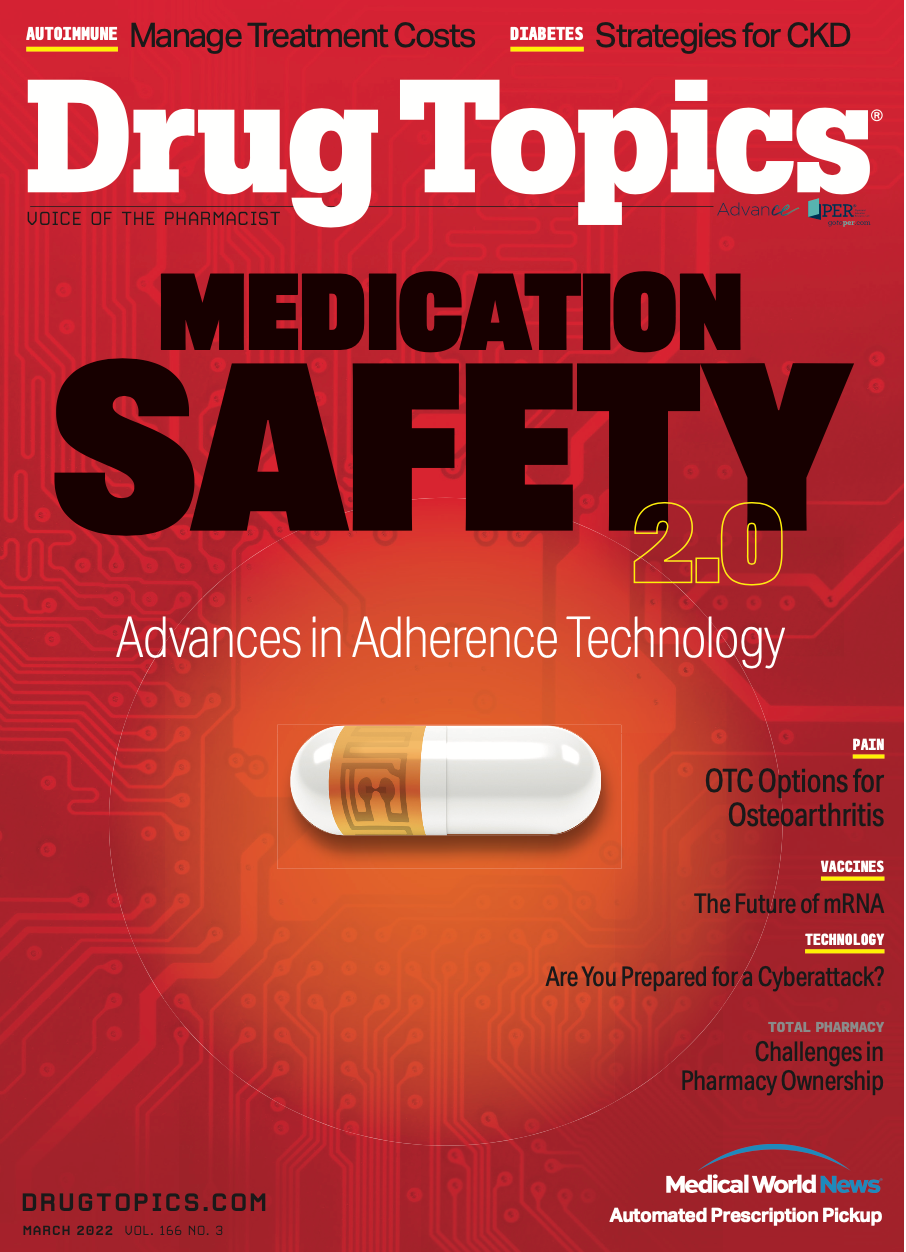OTC Review: Treatment Options for Osteoarthritis
Before seeing a physician, patients can try to treat osteoarthritis pain with OTC remedies.
Osteoarthritis (OA) is the most common form of arthritis, affecting more than 32.5 million adults in the United States.1 Although there is no cure for this degenerative joint disease, a variety of OTC medications can help with pain management, according to the American College of Rheumatology/Arthritis Foundation guidelines.2 Pharmacists can play a key role in counseling and recommending OTC pain management options.
Recommendations and Counseling Pearls
Dietary Supplements
Although glucosamine products are some of the most used dietary supplements in the United States, they should not be recommended for knee, hip, and/or hand OA. Many clinical trials have demonstrated a lack of benefit vs placebo.2 Chondroitin sulfate, often found in combination with glucosamine, is also not recommended for knee and/or hip OA. However, it is conditionally recommended for hand OA.2 Patients taking anticoagulants (eg, warfarin) can have an increased risk of bleeding with glucosamine and chondroitin sulfate.
Because dietary supplements are not regulated by the FDA, patients should check their products for the USP Verified Mark to ensure the quality of the product.3
Oral Nonsteroidal Anti-inflammatory Drugs
Oral nonsteroidal anti-inflammatory drugs (NSAIDs), such as ibuprofen (Motrin) and naproxen (Aleve), are considered the most effective for knee, hip, and/or hand OA pain management. It is important to take these medications with food,2 and treatment should be for the shortest duration and at the lowest dose possible because of the risk of gastrointestinal (GI), cardiovascular (CV), and renal adverse effects.4 Patients may need GI prophylaxis with a proton pump inhibitor to reduce this risk.
Osteoarthritis Treatment Recommendations

Patients should be counseled on the signs and symptoms of CV problems—chest pain, shortness of breath or breathing difficulty, sudden weakness or numbness in one part or side of the body, or sudden slurred speech—and be directed to report those symptoms.4 The FDA previously strengthened the existing Drug Facts labels for all OTC nonaspirin NSAIDs to emphasize the increased risk of myocardial infarction (MI) and stroke.4 Patients with a history of MI or stroke should avoid oral NSAIDs.4
Topical Agents
Topical NSAIDs have less risk of systemic exposure compared with oral agents. They are strongly recommended for knee OA and conditionally recommended for hand OA.2 Diclofenac 1% (Voltaren Arthritis Pain) should be applied on up to 2 joint areas 4 times daily to clean, dry skin.5 Patients should wash their hands thoroughly after applying the gel unless they are applying it to their hands. Remind patients to wash their hands 1 hour after application.5
Diclofenac gel should not be applied to skin that is broken or infected, and patients should avoid the gel making contact with their eyes, nose, or mouth.5 Remind patients that the dosing card should always be used to measure a dose of this product.5 After 21 days, patients should consult a physician before further use.5 To minimize the risk of adverse effects, oral and topical NSAIDs should not be combined. Topical capsaicin (Zostrix) is conditionally recommended for patients with knee OA but not for hand OA because of the risk of ocular adverse effects from potential contact.2 Topi- cal capsaicin may need to be applied 3 to 4 times a day. It typically takes 2 to 4 weeks to see a benefit. Patients should wash their hands immediately after applying capsaicin. Capsaicin can cause a burning or stinging sensa- tion. Remind patients not to apply the product to broken or irritated skin.
Acetaminophen (Tylenol)
Acetaminophen is conditionally recommended for patients with knee, hip, and/or hand OA.2 Evidence suggests it may not be the most effective medication for OA, but it can be an important treatment option for patients who are unable to take NSAIDs.2 The maximum daily recommended dose of 3000 mg to 4000 mg acetaminophen per day, depending on the product, should not be exceeded because of the risk of hepatotoxicity. Alcohol consumption should be avoided.6 To prevent poten- tial overdose, it is critical to educate patients on the importance of reacing the product label to ensure that they are not taking multiple acetami- nophen-containing products.6
Although OTC products can help, patients should consult a physician if their OA is worsening or if their pain is not relieved by OTC treatments.
Jennifer Gershman, PharmD, CPh, is a drug information pharmacist and medical writer residing in South Florida.
References
- Osteoarthritis (OA). CDC. Reviewed July 27, 2020. Accessed January 26, 2022. https://www.cdc.gov/arthritis/basics/osteoarthritis.htm
- Kolasinski SL, Neogi T, Hochberg MC, et al. 2019 American College of Rheumatology/Arthritis Foundation guideline for the management of osteoarthritis of the hand, hip, and knee. Arthritis Care Res (Hoboken). 2020;72(2):149-162. doi:10.1002/acr.24131
- USP verified products listing. USP Quality Supplements. Accessed January 26, 2022. https://www.quality-supplements.org/verified-products/verified-products-listings
- FDA drug safety communication: FDA strengthens warning that non-aspirin nonsteroidal anti-inflammatory drugs (NSAIDs) can cause heart attacks or strokes. FDA. July 9, 2015. Accessed January 26, 2022. https://www.fda.gov/drugs/drug-safety-and-availability/fda-drug-safety-communication-fda-strengthens-warning-non-aspirin-nonsteroidal-anti-inflammatory
- Over-the-counter Diclofenac gel: What you need to know. Voltaren Arthritis Pain. Accessed January 26, 2022. https://www.voltarengel.com/living-with-arthritis/managing-arthritis/over-the-counter-diclofenac-gel/
- Common medicines containing acetaminophen. Know Your Dose. Accessed January 26, 2022. https://www.knowyourdose.org/common-medicines/
